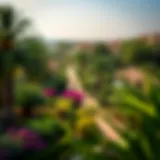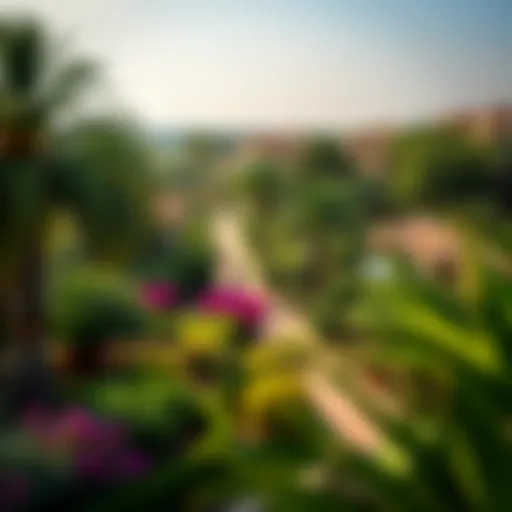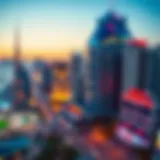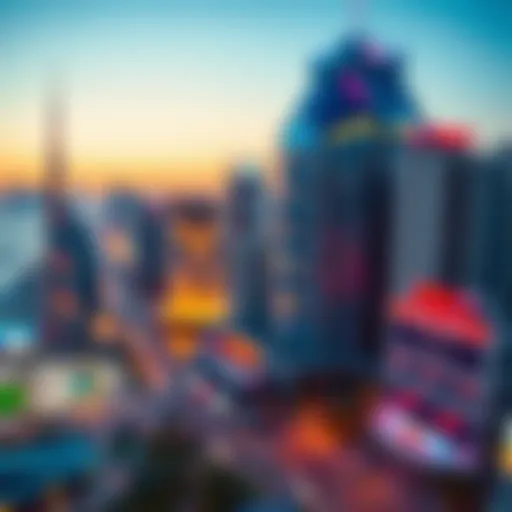Exploring the Al Wasl Building in Karama, Dubai
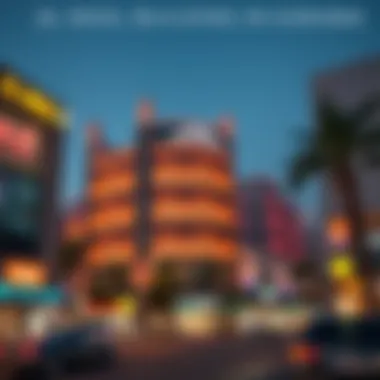
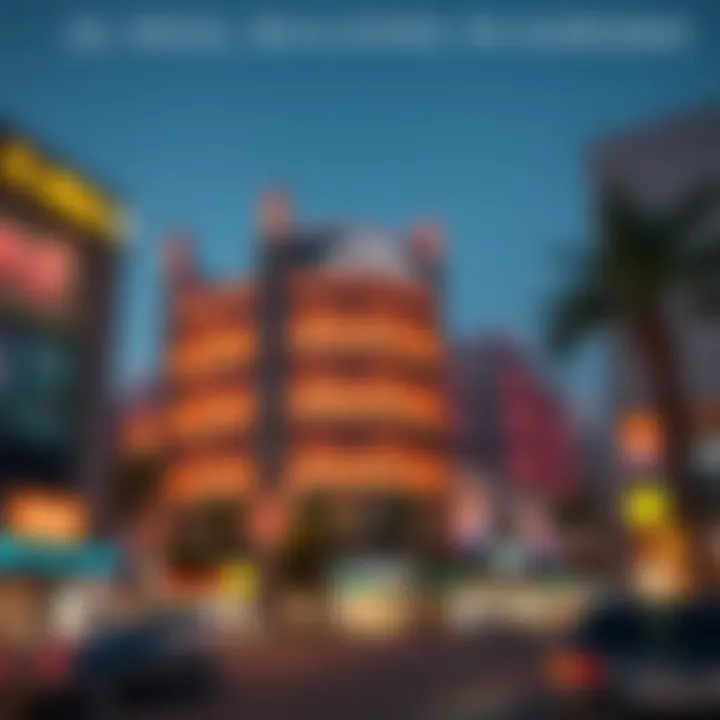
Intro
The Al Wasl Building stands as a prominent fixture in the bustling district of Karama, Dubai. This structure is not only an architectural highlight but also a cultural backbone of the neighborhood. For homeowners, visitors, and urban planners alike, comprehending its layers of significance is crucial. This article will navigate the myriad aspects of the building, focusing on its architectural style, community impact, and the socio-economic ramifications of its presence.
Neighborhood Features
Landscaping Highlights
Nestled in the heart of Karama, the Al Wasl Building is surrounded by a landscape that blends the essence of urban life with touches of natural greenery. The exterior is not just a concrete facade; it's adorned with thoughtfully designed gardens that reflect local flora. Palm trees sway gently, providing shade to passersby. Nearby parks, such as Karama Park, offer a breath of fresh air and act as a communal space for residents to relax or engage in recreational activities. The accessibility to these green spaces enhances the building’s appeal to families and individuals looking for a vibrant lifestyle amidst the urban environment.
Architectural Styles
Architecturally, Al Wasl Building brings together modern aesthetics with elements influenced by traditional Arabic designs. The façade exhibits sleek lines and glass finishes, symbolizing Dubai's forward-thinking urban character. However, subtle traditional motifs can be observed, paying homage to the rich cultural heritage of the region. The building rises prominently against the skyline, having been designed not only for aesthetics but for functionality, catering to the needs of businesses and residents alike. This juxtaposition of styles makes it a conversation starter for architects and design enthusiasts who appreciate the blend of old and new.
Community Life
Local Events and Activities
Life around the Al Wasl Building is vibrant, characterized by numerous local events. Every weekend, the area transforms into a hub of activities ranging from art exhibitions to culinary festivals. Notably, cultural showcases often take place here, spotlighting local artists and businesses. For instance, the annual Karama Festival draws large crowds, celebrating art, music, and community spirit. Such events foster a sense of belonging among residents, creating connections that enhance the neighborhood’s cohesiveness.
Lifestyle Amenities
The proximity of the Al Wasl Building to essential lifestyle amenities cannot be understated. It is closely linked to shopping districts, gyms, and schools. Local markets, filled with spices and traditional goods, are a mere stroll away, making day-to-day living convenient for the residents. Additionally, café culture thrives here; whether it's a cozy spot for breakfast or a place to unwind after a long day, there’s something for everyone. The robust infrastructure surrounding the building also plays a pivotal role in attracting newcomers and retaining the local populace.
"Al Wasl Building is not just a structure; it’s a dynamic locus of community and conversation, of culture and commerce."
For further insights into Dubai's architectural wonders and communal life, consider looking at resources such as Wikipedia, Britannica, and community platforms on Reddit.
This journey through the Al Wasl Building reveals its multifaceted significance in Dubai's ongoing urban narrative.
Prelims to the Al Wasl Building
The Al Wasl Building stands as more than just a physical structure within the landscape of Karama; it is an emblem of architectural ambition and community spirit. Sitting in a bustling part of Dubai, this building reflects a fusion of the city's modern aspirations with its rich cultural heritage. Understanding the significance of the Al Wasl Building requires one to grasp not only its design and construction but also its broader implications within the local context.
Location and Accessibility
The Al Wasl Building finds its home in Karama, a vibrant district known for its bustling streets and diverse population. The location serves as a hub of activity, appealing to residents and visitors alike. Situated just a short drive from major roadways, the building thrives on accessibility. It’s close to public transport, with multiple bus routes and the Dubai Metro making stops nearby, effectively connecting it to the wider city. The strategic placement ensures that it’s not just a landmark but also a functional part of urban life.
Moreover, being within walking distance to schools, parks, and shopping areas makes this site particularly attractive for families and professionals. The blend of convenience and culture around the Al Wasl Building encapsulates what living in Dubai's urban environment is all about.
Historical Context
To truly appreciate the Al Wasl Building, one must delve into its historical roots. Karama itself has undergone tremendous change over the years—from a modest residential area to a thriving commercial locale. The building's inception can be traced back to the early 2000s, when Dubai was eyeing rapid growth. It was envisioned as a symbol of progress in a district that was emerging as a melting pot for various cultures and communities.
This evolution mirrors larger trends in Dubai, where traditional values coexist alongside cutting-edge developments. The structure itself represents this duality; while it showcases modern design, it pays homage to the architectural styles prevalent in earlier times. The Al Wasl Building is, thus, a storybook of the neighborhood’s journey, marking significant milestones in both physical and cultural development.
The Al Wasl Building is not just about its walls; it speaks to the heart of Karama, reflecting its past and present while shaping the future.
In summary, understanding the Al Wasl Building is essential for anyone looking to grasp the changes occurring in Dubai. It is a blend of strategic location and rich historical context, standing firm as a testimony to the dynamic pulse of Karama.
Architectural Features
The Al Wasl Building stands as a testament to modern design fused with cultural significance, reflecting the dynamism of the Karama district in Dubai. Its architectural features not only impress visually but also serve important functional purposes. This section examines the aesthetic and practical elements that define the building's structure.
Design Philosophy
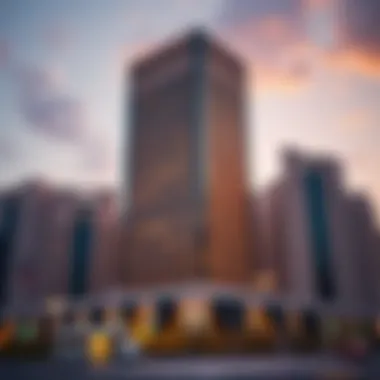
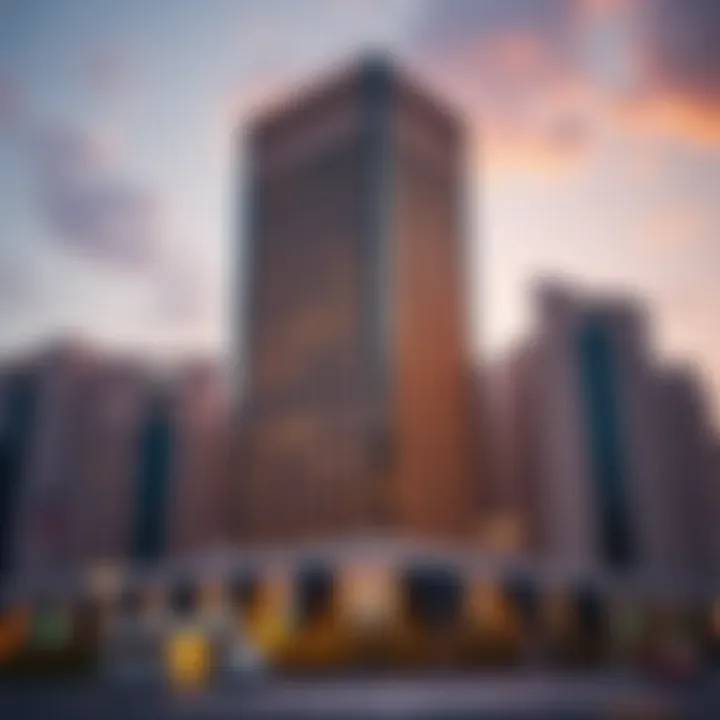
The design philosophy behind the Al Wasl Building is rooted in the concept of harmony between urban life and nature. The architects aspired to create a space that brought people together within a vibrant atmosphere while respecting the surrounding environment. Large glass facades create a seamless transition between inside and out, harnessing natural light to reduce energy consumption during the day.
Moreover, inspired by local traditions, the building subtly incorporates Islamic geometric patterns in its design. This blend of modern aesthetics and cultural significance resonates with both residents and visitors. The use of open spaces and communal areas encourages interaction among the building's users. The focus on sustainability is further amplified through the strategic positioning of the building to utilize wind patterns for natural ventilation.
"Architecture should speak of its time and place, but yearn for the timelessness" – Frank Gehry.
Materials and Techniques
The choice of materials in the Al Wasl Building is both thoughtful and innovative. High-strength concrete and steel frame construction contribute to its durability, essential in a region that experiences extreme temperatures. The incorporation of environmentally friendly materials showcases the building's commitment to sustainable practices.
Exterior cladding includes ceramic tiles that offer thermal insulation, reducing the need for air conditioning. This technique maintains a comfortable indoor climate while minimizing the building's carbon footprint. Inside, local craftsmen were involved to ensure that the finishing touches mirrored traditional techniques, thus preserving the cultural narrative while embracing modernity.
In terms of construction techniques, a combination of prefabrication and traditional methods helped expedite the building process without sacrificing quality. The use of advanced technology allowed for precise measurements and ensured that the structure met safety standards. Appealing not just for its aesthetic but also for its performance, the Al Wasl Building is an exemplary model of how modern architecture can respect and elevate its surroundings.
Community Significance
The vocation of a structure like the Al Wasl Building goes far beyond mere aesthetics or square footage. It becomes a living part of the backdrop in its environment, woven into the fabric of everyday life. For the Karama neighborhood, this building represents more than just a physical space; it's a symbol of the community's pulse and aspirations. Let's delve into the two critical aspects that unveil the community significance of this edifice.
Role in the Karama Neighborhood
The Al Wasl Building stands like a beacon amidst the hustle and bustle of Karama. Its presence serves a multifaceted role in this densely populated area, catering not just to immediate residents but also inviting a broader public interaction. It houses a diverse range of amenities, which makes it a convenient hub for everyday necessities such as grocery shopping, banking, and dining. This positions it as a central locus for both locals and visitors.
More importantly, the building acts as a bridge connecting various cultural and social dimensions within Karama. It serves as a meeting point for people from different walks of life. Whether it’s families grabbing a meal after shopping, young adults chatting over coffee, or retirees discussing the weather, the interactions shaped here help to fortify community bonds.
Some notable aspects of this role include:
- Economic Activity: The businesses operating within Al Wasl Building not only provide necessary goods and services but also contribute to the local economy. Small shop owners thrive on foot traffic generated by the building's popularity.
- Social Interaction: Because of its amenities, the building draws people together, fostering a sense of community cohesion. Local events and markets sometimes pop up in the area, increasing social engagement among diverse groups.
- Cultural Hub: The building often hosts art exhibitions or cultural showcases which reflect the local heritage, bringing together the rich tapestry of cultures that define Karama.
Intersection with Local Culture
The Al Wasl Building does not merely exist; it flourishes amid the cultural mosaic that is Karama. Its architectural style, while modern, incorporates subtle design elements that pay homage to Dubai's cultural heritage. This blending of the old and new reflects the community’s character, where tradition meets contemporary aspirations.
Artistic displays, including murals and sculptures by local artists, adorn the interior and exterior spaces, inviting residents to reflect on their heritage while embracing modernity. Events such as diwali festivals and Eid celebrations find a home within the building, reinforcing cultural identity at every turn.
- Cultural Celebrations: Various festivities are organized within its vicinity, making it a focal point where people gather to share in cultural practices. This transforms the space into a living gallery of cultural expression.
- Local Businesses: Shops and cafes not only cater to the local palate but also offer a taste of the diverse ethnic backgrounds represented in the neighborhood, making each visit an enriching experience.
The Al Wasl Building isn’t just a structure; it’s a vibrant reminder that community and culture are two sides of the same coin, nurturing personal connections and shared values.
In summary, the community significance of the Al Wasl Building in Karama can be seen in how it integrates economic vitality with cultural richness. It’s not simply about shelter but about fostering relationships and creating a landscape where culture shines. This connection is crucial in maintaining the vibrancy that Karama is known for.
Socio-Economic Implications
The Al Wasl Building does not merely symbolize architectural prowess; it also plays a pivotal role in the socio-economic landscape of the Karama area. Understanding the implications of its presence is crucial for stakeholders ranging from homeowners to urban planners. With the rapid transformation of this district of Dubai, the consequences borne from such a prominent structure deserve thorough analysis. This section shines a spotlight on the building's influence on property values and the employment opportunities it fosters, offering insights that cater to diverse audience interests.
Impact on Property Values
The presence of a landmark like the Al Wasl Building can significantly affect local property values. This edifice, due to its distinctive architecture and strategic location, serves to enhance the appeal of the surrounding neighborhood. When properties near notable infrastructure develop, they often see an increase in demand. Homebuyers and renters are naturally drawn to locations that boast a mix of modern amenities and cultural significance.
Some key aspects to consider include:
- Increased Demand: Properties nearby generally appreciate in value as new interest arises. For instance, a modest flat in Karama could see its market price soar, as people become increasingly eager to live near the Al Wasl Building.
- Investment Potential: Investors eye such developments for potential returns. A property’s value is not just about its bricks and mortar, but its association with leading landmarks.
- Commercial Attraction: Given its iconic status, the building encourages businesses to set shop in the area. Retail establishments, restaurants, and service providers often flourish in neighborhoods with high foot traffic, leading to increased rental prices and property valuations.
"The ripple effects of landmark developments often extend far beyond mere aesthetics, reaching deep into economic potential and community growth."
Employment Opportunities

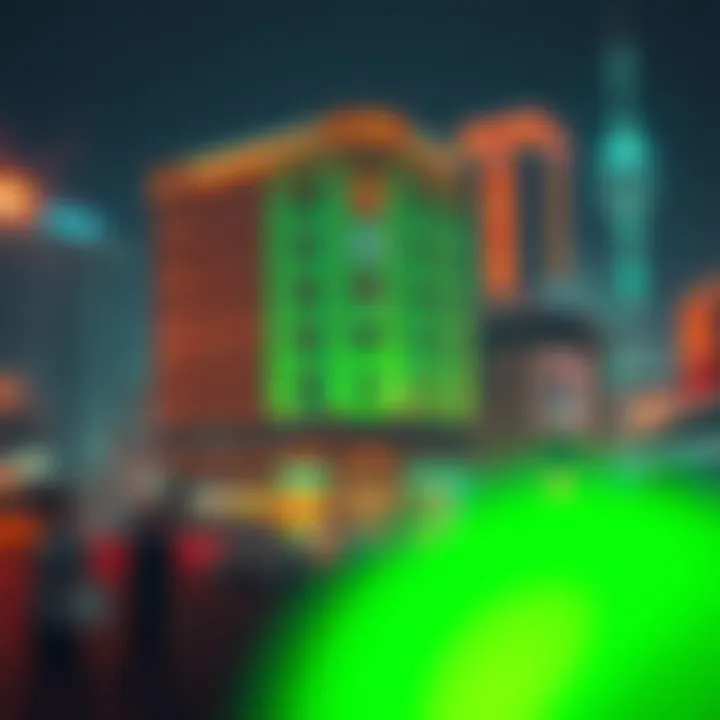
Another crucial socio-economic facet of the Al Wasl Building is the employment opportunities it brings. As a feature of the Karama area, the building contributes to job creation directly and indirectly. From construction jobs to ongoing maintenance and various services, the ripple effects touch many facets of the local economy. Some specific points include:
- Construction Jobs: Initial phases of development boost jobs, providing a significant economic influx to local labor markets.
- Ongoing Employment: Once operational, a building like Al Wasl creates positions not just in management, but across various sectors such as hospitality, security, and maintenance. Each of these roles fosters community growth.
- Entrepreneurial Ventures: The building can attract entrepreneurs looking to establish businesses that cater to both residents and visitors. Success stories in cafe, retail, and service industries can often trace their roots back to such emblems of progress.
In summary, the Al Wasl Building's socio-economic implications stretch far beyond its physical presence. Its impact on property values and employment opportunities significantly contributes to the growth and vibrancy of Karama, emphasizing the intersection of architecture and community dynamics.
Environmental Considerations
Understanding the environmental considerations surrounding the Al Wasl Building is crucial, especially in a rapidly developing urban landscape like Dubai. The integration of sustainable practices and intentional green spaces not only enhances the aesthetic appeal of a building but also contributes significantly to the ecological balance within the community.
Sustainable Practices
The design and operation of the Al Wasl Building incorporate numerous sustainable practices that reflect a shift towards eco-friendliness in architecture. The use of energy-efficient systems is paramount, with technologies that minimize energy consumption while maintaining comfortable living and working conditions. For instance, energy-efficient lighting and heating systems help reduce the carbon footprint of the building.
Moreover, sourcing materials locally can significantly lessen the ecological impact during construction. By using materials such as recycled metal and sustainably-sourced wood, the building exemplifies how urban architecture can align with environmental responsibility. This approach not only supports local economies but also ensures that transportation emissions related to material importation are minimized.
- Water conservation practices: Rainwater harvesting systems are implemented in the building, providing an effective way to utilize natural resources. This system not only alleviates the demand on local water supplies but also encourages a mindset of sustainable consumption among residents.
- Renewable energy: Solar panels supplement the building’s energy needs, further promoting the use of renewable resources.
By integrating these sustainable features, the Al Wasl Building establishes itself not just as a place of habitation but as a model for future developments.
Green Spaces and Landscaping
Green spaces are essential to any urban environment, and the Al Wasl Building does not disappoint in this regard. Thoughtful landscaping provides not only a visual respite from urban concrete but also serves practical purposes. The inclusion of native plants contributes to biodiversity, offering habitats for local wildlife while requiring minimal water input. These flora selections also minimize the need for extensive irrigation systems.
The design actively incorporates gardens, balconies, and roof terraces where residents can engage with nature. These spaces are not merely ornamental; they can also influence the microclimate around the building, providing cooling effects and improving air quality.
"Green architecture is more than just aesthetics; it's about creating a harmonious existence with our environment."
Moreover, having designated recreational areas promotes community interaction. Gardens and parks around the Al Wasl Building serve as meeting points for residents, fostering a sense of community and connection. In essence, the attention to green spaces is beneficial for both environmental health and social well-being, reinforcing the idea that buildings should be integrated into their surroundings instead of existing in isolation.
Current Developments
Current developments around the Al Wasl Building play a crucial role in defining its place within the ever-evolving urban tapestry of Karama. This portion of the analysis not only focuses on the changes that the building itself has undergone but also scrutinizes the broader transformations occurring in the surrounding area. These developments reflect the dynamic nature of Dubai's real estate and community planning, with implications that reach far deeper than just aesthetics.
Recent Renovations
In recent years, the Al Wasl Building has seen significant renovations aimed at refreshing its appearance and enhancing its functionality. These updates were not merely cosmetic; they have strengthened the building's role within the community while aligning it with contemporary architectural trends. For instance, the introduction of modern glass facades has not only improved aesthetic appeal but has also enhanced natural light within the premises, making the interior more welcoming.
- Modern Interiors: The interior spaces have been redesigned with an emphasis on flexibility, accommodating a variety of events and activities common in urban environments.
- Advanced Technologies: Integration of smart-building technologies such as energy-efficient heating and cooling systems demonstrates a move towards sustainability, making the Al Wasl Building not just a physical structure, but a part of the environmentally conscious urban fabric of Dubai.
Such renovations provide practical benefits, improving the building’s energy efficiency and appealing to a broader audience of visitors and residents alike.
Future Expansion Plans
Looking ahead, there are ambitious plans for further expansion of the Al Wasl Building. These plans reflect an understanding of the growing population and evolving needs of the Karama district. Among the proposed developments are additional retail spaces and community areas that aim to further enhance the building's role as a hub for local activity.
- Adding Retail Spaces: The anticipated addition of boutiques and local markets directly within the building is expected to stimulate local commerce and create a vibrant community gathering spot.
- Community-Centric Areas: Plans for outdoor spaces such as gardens or plazas will encourage social interaction among residents and visitors, fostering a sense of unity and engagement.
The combination of recent renovations and future expansions signals a commitment to not only preserving the Al Wasl Building’s legacy but also enhancing its relevance in a changing urban landscape. These developments underscore the importance of adapting historical structures to meet the demands of modern life, thereby retaining their significance while promoting growth.
Investing in updates to such a landmark boosts its value and relevance, while also positively impacting the community as a whole.
As these developments unfold, they will likely further cement the Al Wasl Building's position as a keystone in the Karama district, demonstrating how thoughtful urban planning can shape communities.
Comparative Analysis
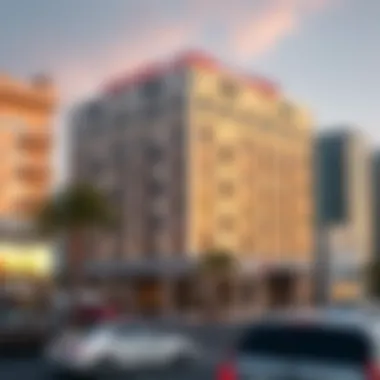
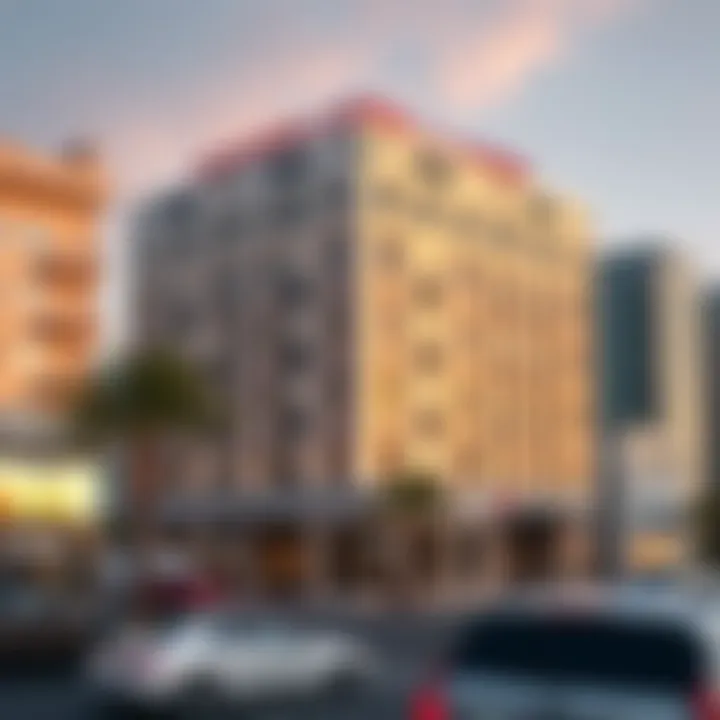
When examining the Al Wasl Building in Karama, a comparative analysis opens up a richer understanding of its role and architectural significance. This section emphasizes juxtaposing the Al Wasl Building with similar structures in Dubai and recognizing the influence of international design elements. This approach does not merely highlight the Al Wasl Building but provides a broader context, engaging potential homeowners, visitors, planners, and architects.
Similar Buildings in Dubai
Dubai, known for its skyline filled with iconic buildings, hosts various structures that resonate with the Al Wasl Building's features. For instance:
- Burj Khalifa: While primarily a vertical marvel, its sleek lines and modern glass façade also serve as a benchmark in Dubai’s architectural narrative.
- The Dubai Mall: As a hub of activity, The Dubai Mall integrates consumer culture with artistic expression, showcasing how community-centric designs can attract foot traffic.
- Dubai Design District: With its focus on creative industries, this district also emphasizes contemporary architecture, making it vital for comparison.
By positioning the Al Wasl Building against these noteworthy structures, one observes distinct characteristics that define not just the Al Wasl it's self but the architectural dialogue in which it exists. Elements such as façade designs, usage of space, and the integration of public and private areas can be distinctly analyzed to reveal how the Al Wasl Building distinguishes itself within this vibrant tapestry.
Influences from International Design
The influence of global architectural trends can be seen weaving through various Dubai buildings, including the Al Wasl Building. The designers likely drew inspiration from numerous sources:
- Modern Minimalism: This trend highlights simplicity, focusing on clean lines and open spaces, often encouraging a layout that feels more inviting.
- Sustainability Principles: Many international architects prioritize eco-friendly designs, a notion that's increasingly essential in today’s construction practices. Incorporating natural light and green roofs can be observed in Al Wasl, akin to principles adopted globally.
- Cultural Integration: Just as some designs in Europe merge local heritage with contemporary needs, the Al Wasl Building also seeks to honor its cultural surroundings while maintaining a modern aesthetic.
"Architecture is the learned game, correct and magnificent, of forms assembled in the light." – Le Corbusier
Understanding these influences can enrich one’s appreciation for the Al Wasl Building, demonstrating that it is not merely a standalone structure but part of an ongoing global conversation about architecture and urban planning.
Through comparative analysis, it becomes clear that the Al Wasl Building holds unique value within Karama, reflecting the intricate interplay of local inspirations and international design languages.
Public Perception
Public perception serves as a lens through which the Al Wasl Building is viewed, not just as an architectural landmark but also as an integral part of the Karama community and its development. The impressions of residents, visitors, and stakeholders shape the narrative surrounding this structure. Aspects such as aesthetic appeal, functionality, and impact on daily life play a crucial role in influencing how this building is perceived by diverse groups. In a rapidly changing urban landscape like Dubai, the voice of the community becomes increasingly vital.
Community Feedback
The community feedback around the Al Wasl Building highlights a tapestry of opinions that reflect both pride and concern. Many residents regard the building as a symbol of progress, elevating the area’s profile and enhancing the neighborhood�’s vibrancy. They appreciate its modernity and how it stands out amongst other structures in Karama. However, there are voices that raise eyebrows over gentrification worries. These individuals feel that such developments might alter the socio-economic fabric of the community, potentially leading to the displacement of long-standing residents.
- Positive remarks often focus on:
- On the flip side, criticisms tend to center on:
- The architectural beauty the building brings to the neighborhood.
- Increased foot traffic and activity stimulating local businesses.
- Rising property prices which might squeeze out lower-income families.
- Changes in the local culture and identity that come with new developments.
Engagement with local forums and social media platforms like Reddit or Facebook can provide a glimpse into the ongoing dialogue. These platforms offer a space where individuals from various backgrounds come together to discuss their thoughts. This feedback plays an important role in shaping future discussions regarding urban development and community cohesion, leading to a richer understanding of the building's implications.
Media Representation
Media representation of the Al Wasl Building helps solidify its place in the public consciousness. Through various channels, from online articles to traditional news segments, the portrayal varies markedly, painting both rosy and critical pictures. When covered in lifestyle magazines and travel blogs, the building often becomes a focal point showcasing Dubai’s architectural innovation. Often, it’s depicted as a must-see destination, linking it closely with the city’s modernization narrative.
However, mainstream media analyses sometimes delve deeper, questioning the socio-economic ramifications of such urban designs. Whether it’s through investigative pieces published in established media houses or comments shared on platforms like local newspapers, discussion about how such developments impact local lore is critical.
"Buildings not only tell us stories of the past but predict the future of their surrounding communities."
One noteworthy point of consideration is how digital media has transformed the narrative around the building, allowing for a real-time reflection of public sentiment which may at times clash with official portrayals. This dichotomy underscores the importance of understanding public perception as a fluid concept that is subject to change and heavily influenced by ongoing community conversations. As the Al Wasl Building continues to evolve, both the feedback from the community and media representation will crucially shape its legacy in Dubai.
The End and Reflections
The Al Wasl Building stands as more than just a structure in Karama; it embodies the intersection of history, community, and urban development. As this article has illustrated, the building's architectural significance is matched only by its socio-economic implications within Dubai's ever-evolving landscape.
Reflecting on the insights gained throughout the analysis, we can see that the Al Wasl Building serves a dual purpose. On one end, it is a testament to contemporary architectural design, featuring innovative materials and techniques that echo modernity. On the other, it plays an instrumental role in the local community, acting as a hub for interaction and cultural exchange among residents and visitors alike. Such integration into the fabric of Karama emphasizes the building's relevance and necessity in urban planning.
In the broader scope of Dubai’s urban evolution, the Al Wasl Building is a case study in how architecture can shape social dynamics. It effectively demonstrates that well-planned spaces, frequently orchestrated with local culture in mind, not only uplift property values but also enhance community spirit. Such communal ties are worth nurturing, as they bolster a sense of belonging and pride in one’s surroundings.
Furthermore, the building has illustrated how environmental considerations are increasingly woven into architectural projects. The incorporation of sustainable practices and green spaces is a fundamental element that resonates with today’s conscientious citizens, ensuring that urbanization does not come at the expense of nature.
"A building, after all, is only as good as the people it houses."
In contemplating the future, we acknowledge that continued vigilance is necessary to safeguard the essence of Karama. As investments pour into developments and urban expansion takes shape, balancing modernization with preservation will be crucial to maintain the unique identity of the neighborhood.
The Al Wasl Building's narrative is still unfolding. Stakeholders, including homeowners, architects, and the community, must remain engaged in dialogues about its ongoing role in Karama. This synergy among various entities will ensure that the building not only withstands the test of time but also continues to resonate with the values of its residents.
